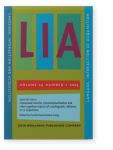Introduction
Transfert conceptuel, (re)conceptualisation et quelques autres aspects cognitifs de l’influence translinguistique dans
l’acquisition d’une L2
Article language: French
References (25)
Références
Athanasopoulos, P., Damjanovic, L., Krajciova, A., & Sasaki, M. (2011). Representation
of colour concepts in bilingual cognition: The case of Japanese blues. Bilingualism: Language
and
Cognition,
14
(1), 9–17. 

Bassetti, B. (2021, juillet 5). Cross-modal
cross-linguistic influence on second language phonology: Consonant spelling and consonant duration in Italian L1 speakers of
English L2 [Keynote conference]. Colloque International du Réseau
d’Acquisition des Langues Secondes (RéAL2), Université Toulouse 2 – Jean Jaurès.
Brown, A., & Gullberg, M. (2011). Bidirectional
cross-linguistic influence in event conceptualization? Expressions of Path among Japanese learners of
English. Bilingualism: Language and
Cognition,
14
(1), 79–94. 

Carroll, M., & von Stutterheim, C. (1993). The
representation of spatial configurations in English and German and the grammatical structure of locative and anaphoric
expressions. Linguistics,
31
(6), 1011–1042. 

Daller, M. H., Treffers-Daller, J., & Furman, R. (2011). Transfer
of conceptualization patterns in bilinguals: The construal of motion events in Turkish and
German. Bilingualism: Language and
Cognition,
14
(1), 95–119. 

Flecken, M. (2011). Event
conceptualization by early Dutch–German bilinguals: Insights from linguistic and eye-tracking
data. Bilingualism: Language and
Cognition,
14
(1), 61–77. 

Jarvis, S. (2007). Theoretical
and methodological issues in the investigation of conceptual transfer. Vigo International
Journal of Applied
Linguistics,
4
1, 43–71.
Jarvis, S. (2011). Conceptual
transfer: Crosslinguistic effects in categorization and construal. Bilingualism: Language and
Cognition,
14
(1), 1–8. 

Jarvis, S. (2016). The
scope of transfer research. In L. Yu & T. Odlin (Eds.), New
perspectives on transfer in second language learning (pp. 17–49). Multilingual Matters.
Jarvis, S., & Pavlenko, A. (2008). Crosslinguistic
influence in language and cognition. Routledge. 

Jessner, U., Megens, M., & Graus, S. (2016). Crosslinguistic
influence in third language acquisition. In R. Alonso Alonso (Ed.), Crosslinguistic
influence in second language
acquisition (pp. 193–214). Multilingual Matters. 

Levelt, W. J. M. (1989). Speaking :
From intention to articulation. MIT Press.
McManus, K. (2022). Crosslinguistic influence and second language learning. Routledge.
Odlin, T. (1989). Language
transfer : Cross-linguistic influence in language learning. Cambridge University Press. 

Odlin, T. (2016). Was
there really ever a Contrastive Analysis Hypothesis? In R. Alonso Alonso (Ed.), Crosslinguistic
influence in second language
acquisition (pp. 1–23). Multilingual Matters. 

Odlin, T. (2022). Explorations
of language transfer. Multilingual Matters.
Odlin, T., & Yu, L. (2016). Introduction. In L. Yu & T. Odlin (Eds.), New
perspectives on transfer in second language
learning (pp. 1–16). Multilingual Matters.
Pavlenko, A. (1998). SLA
and acculturation : Conceptual transfer in L2 learners’
narratives [Paper]. Annual meeting of the American Association for
Applied Linguistics, Seattle, WA.
Pavlenko, A., & Malt, B. C. (2011). Kitchen
Russian : Cross-linguistic differences and first-language object naming by Russian–English
bilinguals. Bilingualism: Language and
Cognition,
14
(1), 19–45. 

Sharwood Smith, M. (1983). Cross-linguistic
aspects of second language acquisition. Applied
Linguistics,
4
(3), 192–199. 

Slobin, D. I. (1987). Thinking
for speaking. Annual Meeting of the Berkeley Linguistics
Society,
13
1, 435. 

Slobin, D. I. (1996). From
thought and language to thinking for speaking. In J. J. Gumperz & S. C. Levinson (Eds.), Rethinking
linguistic
relativity (pp. 70–96). Cambridge University Press.
Strömqvist, S. (2009). Språkets
öga : Om vägarna mellan tankar och ord (1.
uppl). Studentlitteratur.
Strömqvist, S. (2022). On
the nature of language production – Towards a general model. In R. Levie, A. Bar-On, O. Ashkenazi, E. Dattner, & G. Brandes (Eds.), Developing
language and
literacy (Vol. 231, pp. 173–190). Springer International Publishing. 

Whorf, B. (1956). Language,
thought, and reality : Selected writings of Benjamin Lee Whorf (J. B. Carroll, Ed.). MIT Press.
